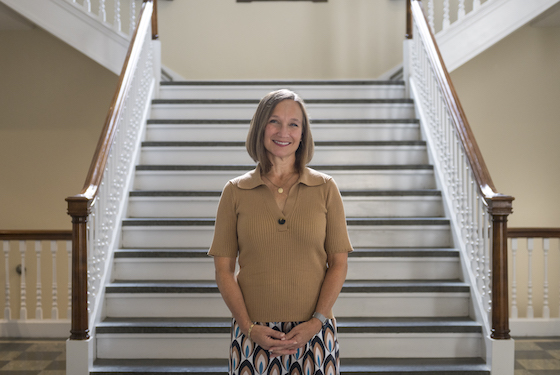Growing the Graduate School

From Hood Magazine fall 2023.
Hood Magazine Fall 2023
Department
- Computer Science & Information Technology
- English & Communication Arts
- Nursing
- Psychology & Counseling
April Boulton, Ph.D., dean of the Graduate School at Hood College, discusses new programs and evolving trends in higher education.
What new programs has the Graduate School added to its offerings?
You’ll see an expanded portfolio of offerings from diverse disciplines, including counseling, creative writing, nursing and health informatics—which is heavily nested in data science and computing—so we have the humanities, STEM and health fields represented.
Tell us about the Graduate School’s growth in online programs.
While many of our programs continue to flourish in hybrid and traditional classroom modalities, we have seen a consistent, growing need for flexible online formats, which aligns with national and regional trends. This pattern was well established pre-COVID, but the advent of platforms like Zoom and Teams has only hastened this expanding interest in fully online programs.
Our graduate students are almost all full-time professionals, caregivers, volunteers and more, so they are increasingly looking for program modalities that fit their packed schedules. Added to that reality is the national embrace of teleworking and telehealth. These services and virtual options have magnified a similar preference for “tele-education,” which, of course, has been around for a few decades in the form of distance learning and online education.
As a result, we are strategically expanding our online offerings, as evidenced by our long-standing MBA program transitioning to a fully online delivery starting this year. Currently, all of our education and several computing graduate degrees are online. Some new additions, like graduate-level nursing, will be fully online as well.
How has the Graduate School student body evolved in the past few years?
Our graduate students have always been from “two generational worlds,” namely young, early-career professionals (often right out of college) and older, established career professionals. However, one change is clear: that younger group is becoming more sizable every year. We used to see a 1:2 or 1:3 ratio of young to mature students, but more and more we’re seeing ratios approaching 1:1.
This is evidenced by significant growth in our 4PLUS dual-degree program and ALTY (Alumni of the Last Three Years) Scholarship recipients, but our overall age distribution further reflects this trend. Put simply: new graduates from baccalaureate programs see the cost and time savings of adding a master’s degree to their educational profile. They also know that salary data consistently show professionals with master’s degrees outearn bachelor’s degree holders.
What trends are you seeing in graduate education? How is Hood responding?
Graduate students are not only interested in flexible degree options that will elevate their career, but they are also interested in the auxiliary benefits such graduate programs provide, like holistic wellness programs, academic support services, on-campus housing and dining options, creative ways to network with peers and graduate-level internship experiences. These features are standard in undergraduate programs, but they are increasingly valued and sought out at the graduate level.
This shifting landscape could be due, in part, to the growing younger demographic enrolling in graduate programs. Such services and experiences are top of mind, as these students recently graduated from a bachelor’s program, and they expect a level of continuation in graduate school. We welcome this expectation from students. Since Hood has a history of robust auxiliary and support services at the undergraduate level, this is already a strength we can and do extend to our graduate students.
Read the full issue of Hood Magazine here.
Are you ready to say Hello?
Choose a Pathway
Information will vary based on program level. Select a path to find the information you're looking for!
